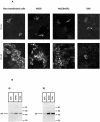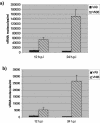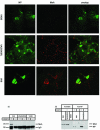Human MxA protein inhibits the replication of Crimean-Congo hemorrhagic fever virus
- PMID: 15047845
- PMCID: PMC374267
- DOI: 10.1128/jvi.78.8.4323-4329.2004
Human MxA protein inhibits the replication of Crimean-Congo hemorrhagic fever virus
Abstract
Crimean-Congo hemorrhagic fever virus (CCHFV) belongs to the genus Nairovirus within the family Bunyaviridae and is the causative agent of severe hemorrhagic fever. Despite increasing knowledge about hemorrhagic fever viruses, the factors determining their pathogenicity are still poorly understood. The interferon-induced MxA protein has been shown to have an inhibitory effect on several members of the Bunyaviridae family, but the effect of MxA against CCHFV has not previously been studied. Here, we report that human MxA has antiviral activity against CCHFV. The yield of progeny virus in cells constitutively expressing MxA was reduced up to 1,000-fold compared with control cells, and accumulation of viral genomes was blocked. Confocal microscopy revealed that MxA colocalizes with the nucleocapsid protein (NP) of CCHFV in the perinuclear regions of infected cells. Furthermore, we found that MxA interacted with NP by using a coimmunoprecipitation assay. We also found that an amino acid substitution (E645R) within the C-terminal domain of MxA resulted in a loss of MxA antiviral activity and, concomitantly, in the capacity to interact with CCHFV NP. These results suggest that MxA, by interacting with a component of the nucleocapsid, prevents replication of CCHFV viral RNA and thereby inhibits the production of new infectious virus particles.
Figures




Similar articles
-
Type I interferon inhibits Crimean-Congo hemorrhagic fever virus in human target cells.J Med Virol. 2006 Feb;78(2):216-22. doi: 10.1002/jmv.20530. J Med Virol. 2006. PMID: 16372299
-
Heat Shock Protein 70 Family Members Interact with Crimean-Congo Hemorrhagic Fever Virus and Hazara Virus Nucleocapsid Proteins and Perform a Functional Role in the Nairovirus Replication Cycle.J Virol. 2016 Sep 29;90(20):9305-16. doi: 10.1128/JVI.00661-16. Print 2016 Oct 15. J Virol. 2016. PMID: 27512070 Free PMC article.
-
Crimean-Congo hemorrhagic fever virus delays activation of the innate immune response.J Med Virol. 2008 Aug;80(8):1397-404. doi: 10.1002/jmv.21222. J Med Virol. 2008. PMID: 18551619
-
Crimean-Congo Hemorrhagic Fever.Lab Med. 2015 Summer;46(3):180-9. doi: 10.1309/LMN1P2FRZ7BKZSCO. Lab Med. 2015. PMID: 26199256 Review.
-
The Role of Nucleocapsid Protein (NP) in the Immunology of Crimean-Congo Hemorrhagic Fever Virus (CCHFV).Viruses. 2024 Sep 30;16(10):1547. doi: 10.3390/v16101547. Viruses. 2024. PMID: 39459881 Free PMC article. Review.
Cited by
-
Cell array-based intracellular localization screening reveals novel functional features of human chromosome 21 proteins.BMC Genomics. 2006 Jun 16;7:155. doi: 10.1186/1471-2164-7-155. BMC Genomics. 2006. PMID: 16780588 Free PMC article.
-
Viral zoonoses in Europe.FEMS Microbiol Rev. 2005 Nov;29(5):1051-77. doi: 10.1016/j.femsre.2005.04.012. Epub 2005 Jun 29. FEMS Microbiol Rev. 2005. PMID: 16024128 Free PMC article. Review.
-
Induction of caspase activation and cleavage of the viral nucleocapsid protein in different cell types during Crimean-Congo hemorrhagic fever virus infection.J Biol Chem. 2011 Feb 4;286(5):3227-34. doi: 10.1074/jbc.M110.149369. Epub 2010 Dec 1. J Biol Chem. 2011. PMID: 21123175 Free PMC article.
-
Host Cell Restriction Factors of Bunyaviruses and Viral Countermeasures.Viruses. 2021 Apr 28;13(5):784. doi: 10.3390/v13050784. Viruses. 2021. PMID: 33925004 Free PMC article. Review.
-
Interferon-inducible antiviral effectors.Nat Rev Immunol. 2008 Jul;8(7):559-68. doi: 10.1038/nri2314. Nat Rev Immunol. 2008. PMID: 18575461 Free PMC article. Review.
References
-
- Accola, M. A., B. Huang, A. Al Masri, and M. A. McNiven. 2002. The antiviral dynamin family member, MxA, tubulates lipids and localizes to the smooth endoplasmic reticulum. J. Biol. Chem. 277:21829-21835. - PubMed
-
- Andersson, I., M. Simon, A. Lundkvist, M. Nilsson, A. Holmstrom, F. Elgh, and A. Mirazimi. 2004. Role of actin filaments in targeting of Crimean Congo hemorrhagic fever virus nucleocapsid protein to perinuclear regions of mammalian cells. J. Med. Virol. 72:83-93. - PubMed
-
- Billecocq, A., M. Vazeille-Falcoz, F. Rodhain, and M. Bouloy. 2000. Pathogen-specific resistance to Rift Valley fever virus infection is induced in mosquito cells by expression of the recombinant nucleoprotein but not NSs non-structural protein sequences. J. Gen. Virol. 81:2161-2166. - PubMed
-
- Bishop, D. H. L. 1996. Biology and molecular biology of bunyaviruses. Plenum Press, New York, N.Y.
-
- Bridgen, A., D. A. Dalrymple, F. Weber, and R. M. Elliott. 2004. Inhibition of Dugbe nairovirus replication by human MxA protein. Virus Res. 99:47-50. - PubMed
Publication types
MeSH terms
Substances
LinkOut - more resources
Full Text Sources
Molecular Biology Databases
Miscellaneous

